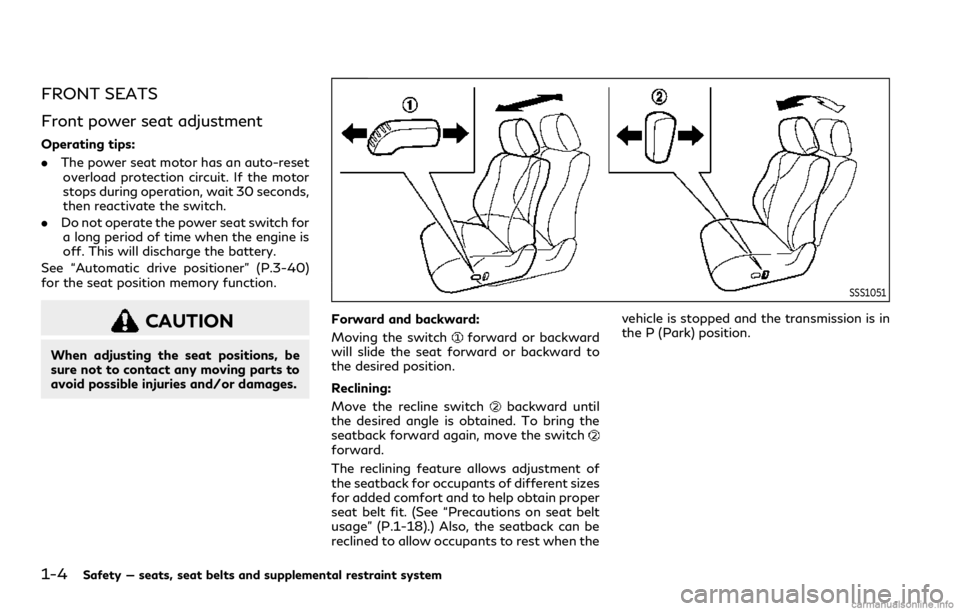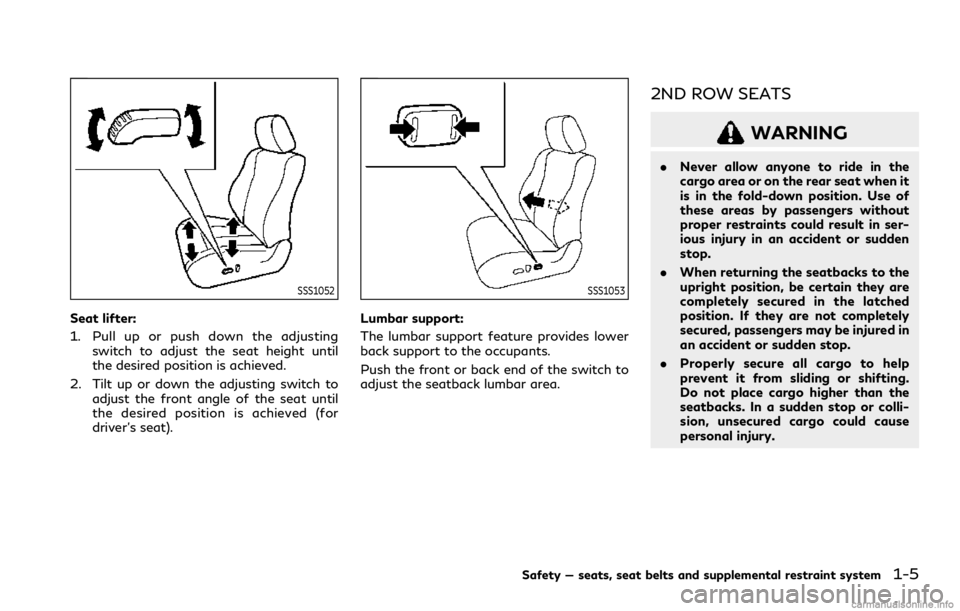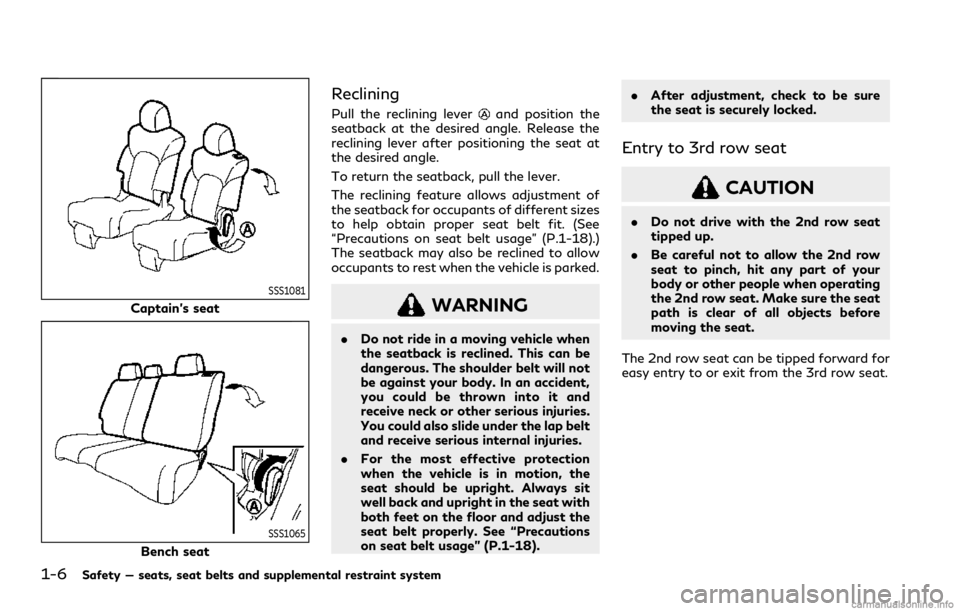seats INFINITI QX80 2021 Owner's Manual
[x] Cancel search | Manufacturer: INFINITI, Model Year: 2021, Model line: QX80, Model: INFINITI QX80 2021Pages: 529, PDF Size: 2.05 MB
Page 12 of 529

Illustrated table of contents0
Safety — seats, seat belts and supplemental restraint
system1
Instruments and controls
Pre-driving checks and adjustments
Monitor, climate, audio, phone and voice recognition
systems
Starting and driving
In case of emergency
Appearance and care
Do-it-yourself
Maintenance and schedules
Technical and consumer information
2
3
4
5
6
7
8
9
10
Table of
Contents
11Index
Page 14 of 529

0 Illustrated table of contents
Seats, seat belts and Supplemental Restraint
System (SRS) ...................................................................... 0-2
Exterior front ..................................................................... 0-3
Exterior rear ....................................................................... 0-5
Passenger compartment ................................................. 0-6
Cockpit ........................................................................\
......... 0-8Instrument panel ........................................................... 0-10
Meters and gauges ........................................................ 0-12
Engine compartment ..................................................... 0-13
VK56VD engine ....................................................... 0-13
Warning and indicator lights ..................................... 0-14
Page 15 of 529

0-2Illustrated table of contents
WAA0130X
1. Seat belt for 3rd row center seat(P.1-25)
2. Roof-mounted curtain side-impact and rollover supplemental air bags (P.1-52)
3. Head Restraints (P.1-13) — Front-seat Active Head Restraints
(P.1-17)
4. Seat belts (P.1-18)
5. Front seat-mounted side-impact sup- plemental air bags (P.1-52) 6. Supplemental front-impact air bags
(P.1-52)
7. Child restraint anchor points (for top tether strap child restraint) (P.1-44,
P.1-48)
8. 3rd row seats (P.1-8) — Child restraints (P.1-31)
9. LATCH (Lower Anchors and Tethers for CHildren) system (P.1-34)
10. Armrest (2nd row seat) (P.1-10)
11. 2nd row seats (P.1-5) — Child restraints (P.1-31)
12. Seat belt pretensioner (P.1-67)
13. Front armrest (P.1-10)
14. Front seats (P.1-4) — Occupant classification sensors
(weight sensors) (P.1-58)
15. Front passenger air bag status light (P.1-60)
SEATS, SEAT BELTS AND
SUPPLEMENTAL RESTRAINT
SYSTEM (SRS)
Page 23 of 529

0-10Illustrated table of contents
WAA0133X
1. Side ventilator (P.4-27)
2. Meters and gauges (P.2-6)
3. Hazard warning flasher switch (P.6-2)
4. Center ventilator (P.4-27)
5. Upper touch screen display (upper dis-play) (See INFINITI InTouch
TMOwner’s Manual.)
— Around View
®Monitor (P.4-3)
— Navigation system (See INFINITI
InTouch
TMOwner’s Manual.) 6. Lower touch screen display (lower dis-
play) (See INFINITI InTouch
TMOwner’s
Manual.)
7. Heater and air conditioner control (P.4-28)
— Heated seats switch (P.2-48)
— Climate controlled seats switch (if so
equipped) (P.2-50)
— Defroster switch (P.2-39)
8. Front passenger air bag status light (P.1-60)
9. Audio system (See INFINITI InTouch
TM
Owner’s Manual.)
10. Front passenger supplemental air bag (P.1-52)
11. Fuse box (P.8-20)
12. Parking brake (P.5-22)
13. Hood release handle (P.3-21)
14. Steering wheel — Horn (P.2-48)
— Driver supplemental air bag (P.1-52)
— Power steering system (P.5-123)
15. Push-button ignition switch (P.5-12)
16. Front console — Power outlet (P.2-56)
— USB connection port (See Infiniti
InTouch Owner’s Manual.)
INSTRUMENT PANEL
Page 28 of 529

1 Safety — seats, seat belts and supplementalrestraint system
Seats ........................................................................\
.............. 1-3
Front seats .................................................................... 1-4
2nd row seats ............................................................... 1-5
3rd row seats ............................................................... 1-8
Armrest (if so equipped) .......................................... 1-10
Flexible seating .......................................................... 1-10
Head restraints/headrests ........................................... 1-13 Adjustable head
restraint/headrest components ............................ 1-14
Non-adjustable head
restraint/headrest components ............................ 1-15
Remove ........................................................................\
1-15
Install ........................................................................\
.... 1-16
Adjust ........................................................................\
... 1-16
Front-seat Active Head Restraint ........................ 1-17
Seat belts ........................................................................\
.. 1-18
Precautions on seat belt usage ............................. 1-18
Pregnant women ....................................................... 1-21
Injured persons ........................................................... 1-21
Pre-crash seat belts with comfort function
(if so equipped for front seats) ............................. 1-21
Three-point type seat belt ...................................... 1-21
Seat belt extenders ................................................... 1-28
Seat belt maintenance ............................................. 1-28 Child safety ...................................................................... 1-29
Infants ........................................................................\
1-30
Small children ........................................................... 1-30
Larger children ......................................................... 1-30
Child restraints ................................................................ 1-31 Precautions on child restraints ............................ 1-31
Lower Anchors and Tethers for CHildren
System (LATCH) ...................................................... 1-33
Top tether strap child restraint ........................... 1-36
Rear-facing child restraint installation
using LATCH ............................................................ 1-37
Rear-facing child restraint installation using
the seat belts ............................................................ 1-39
Forward-facing child restraint installation
using LATCH ............................................................ 1-41
Forward-facing child restraint installation
using the seat belts ................................................ 1-44
Booster seats ........................................................... 1-48
Supplemental restraint system .................................. 1-52
Precautions on supplemental
restraint system ....................................................... 1-52
INFINITI Advanced Air Bag System
(front seats) .............................................................. 1-58
Front seat-mounted side-impact supplemental
air bag and roof-mounted curtain side-impact
and rollover supplemental air bag systems ..... 1-65
Page 29 of 529

Seat belts with pretensioners (front seats) ....... 1-67
Supplemental air bag warning labels .................. 1-68Supplemental air bag warning light ................... 1-69
Repair and replacement procedure .................... 1-69
Page 30 of 529

SSS0133
WARNING
.Do not ride in a moving vehicle when
the seatback is reclined. This can be
dangerous. The shoulder belt will not
be against your body. In an accident,
you could be thrown into it and
receive neck or other serious injuries.
You could also slide under the lap belt
and receive serious internal injuries.
. For the most effective protection
when the vehicle is in motion, the
seat should be upright. Always sit
well back and upright in the seat with both feet on the floor and adjust the
seat belt properly. See “Precautions
on seat belt usage” (P.1-18).
. After adjustment, gently rock in the
seat to make sure it is securely
locked.
. Do not leave children unattended
inside the vehicle. They could un-
knowingly activate switches or con-
trols. Unattended children could
become involved in serious accidents.
. To help avoid risk of injury or death
through unintended operation of the
vehicle and/or its systems, do not leave children, people who require the
assistance of others or pets unat-
tended in your vehicle. Additionally,
the temperature inside a closed ve-
hicle on a warm day can quickly
become high enough to cause a sig-
nificant risk of injury or death to
people and pets.
. The seatback should not be reclined
any more than needed for comfort.
Seat belts are most effective when
the passenger sits well back and
straight up in the seat. If the seat-
back is reclined, the risk of sliding
under the lap belt and being injured is
increased.
Safety — seats, seat belts and supplemental restraint system1-3
SEATS
Page 31 of 529

1-4Safety — seats, seat belts and supplemental restraint system
FRONT SEATS
Front power seat adjustment
Operating tips:
.The power seat motor has an auto-reset
overload protection circuit. If the motor
stops during operation, wait 30 seconds,
then reactivate the switch.
. Do not operate the power seat switch for
a long period of time when the engine is
off. This will discharge the battery.
See “Automatic drive positioner” (P.3-40)
for the seat position memory function.
CAUTION
When adjusting the seat positions, be
sure not to contact any moving parts to
avoid possible injuries and/or damages.
SSS1051
Forward and backward:
Moving the switch
forward or backward
will slide the seat forward or backward to
the desired position.
Reclining:
Move the recline switch
backward until
the desired angle is obtained. To bring the
seatback forward again, move the switch
forward.
The reclining feature allows adjustment of
the seatback for occupants of different sizes
for added comfort and to help obtain proper
seat belt fit. (See “Precautions on seat belt
usage” (P.1-18).) Also, the seatback can be
reclined to allow occupants to rest when the vehicle is stopped and the transmission is in
the P (Park) position.
Page 32 of 529

SSS1052
Seat lifter:
1. Pull up or push down the adjustingswitch to adjust the seat height until
the desired position is achieved.
2. Tilt up or down the adjusting switch to adjust the front angle of the seat until
the desired position is achieved (for
driver’s seat).
SSS1053
Lumbar support:
The lumbar support feature provides lower
back support to the occupants.
Push the front or back end of the switch to
adjust the seatback lumbar area.
2ND ROW SEATS
WARNING
.Never allow anyone to ride in the
cargo area or on the rear seat when it
is in the fold-down position. Use of
these areas by passengers without
proper restraints could result in ser-
ious injury in an accident or sudden
stop.
. When returning the seatbacks to the
upright position, be certain they are
completely secured in the latched
position. If they are not completely
secured, passengers may be injured in
an accident or sudden stop.
. Properly secure all cargo to help
prevent it from sliding or shifting.
Do not place cargo higher than the
seatbacks. In a sudden stop or colli-
sion, unsecured cargo could cause
personal injury.
Safety — seats, seat belts and supplemental restraint system1-5
Page 33 of 529

1-6Safety — seats, seat belts and supplemental restraint system
SSS1081
Captain’s seat
SSS1065
Bench seat
Reclining
Pull the reclining leverand position the
seatback at the desired angle. Release the
reclining lever after positioning the seat at
the desired angle.
To return the seatback, pull the lever.
The reclining feature allows adjustment of
the seatback for occupants of different sizes
to help obtain proper seat belt fit. (See
“Precautions on seat belt usage” (P.1-18).)
The seatback may also be reclined to allow
occupants to rest when the vehicle is parked.
WARNING
. Do not ride in a moving vehicle when
the seatback is reclined. This can be
dangerous. The shoulder belt will not
be against your body. In an accident,
you could be thrown into it and
receive neck or other serious injuries.
You could also slide under the lap belt
and receive serious internal injuries.
. For the most effective protection
when the vehicle is in motion, the
seat should be upright. Always sit
well back and upright in the seat with
both feet on the floor and adjust the
seat belt properly. See “Precautions
on seat belt usage” (P.1-18). .
After adjustment, check to be sure
the seat is securely locked.
Entry to 3rd row seat
CAUTION
.Do not drive with the 2nd row seat
tipped up.
. Be careful not to allow the 2nd row
seat to pinch, hit any part of your
body or other people when operating
the 2nd row seat. Make sure the seat
path is clear of all objects before
moving the seat.
The 2nd row seat can be tipped forward for
easy entry to or exit from the 3rd row seat.